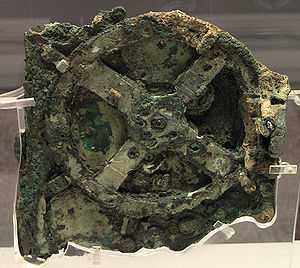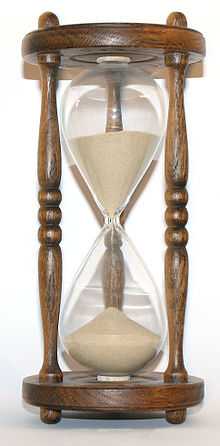Astrarium
An astrarium, also called a planetarium, is the mechanical representation of the cyclic nature of astronomical objects in one timepiece. It is an astronomical clock.
History
Greek and Roman World

The first astraria were mechanical devices. Archimedes is said to have used a primitive version that could predict the positions of the sun, the moon, and the planets. On May 17, 1902, an archaeologist named Valerios Stais discovered a lump of oxidated material with in it a mechanism with cogwheels that had been recovered from a shipwreck near Antikythera. This mechanism, known as the Antikythera mechanism, was recently redated between [150 to 100 BC]. Extensive study of the fragments, using X-rays, have revealed enough details (gears, pinions, crank) to enable researchers to build partial replicas , . Engraved on the major gears are the names of the planets (such as Venus), which leaves little doubt as to the intended use of the mechanism.
However, before the end of the Roman Empire, the know-how and science behind this piece of clockwork would be lost.
Middle Ages and Renaissance
The first documented astrarium clock was completed in 1364 by Giovanni de' Dondi (1318–1388), a scholar and physician of the Middle Ages interested in astronomy and horology. The original clock, consisting of 107 wheels and pinions, was lost, perhaps during the sacking of Mantua in 1630, but de' Dondi left detailed descriptions which have survived, enabling the reconstruction of the clock. It displays the mean time, sidereal, or star, time and the motions of the sun, moon and the five then known planets Venus, Mars, Saturn, Mercury, and Jupiter. It was conceived according to a Ptolemaic conception of the solar system. De' Dondi was inspired by his father Jacopo who had designed the astronomical clock in the Piazzi dei Signori, Padua, in 1344 - one of the first of its type.
In later ages more astraria were built. A famous example is the one built in 1774 by Eise Eisinga from Dronrijp, Friesland, the Netherlands. It displayed all the planets and was fixed to the ceiling in a house in Franeker where it can still be visited.
In modern time the astrarium grew into a tourist attraction as a commercially exploited planetarium showing in IMAX the history of the universe and other astronomical phenomena.
See also
External links
- Annosphere An electro-mechanical model of the earth/sun relationship.
- Science and Society Picture Library: - a picture of De Dondi’s "Astrarium", the world’s first astronomical clock, 1364.
- de Dondi's Astrarium Hi-Tech, 14th Century style
- Het Eise Eisinga Planetarium
- Solar tempometer An astrarium clock running to the sun.
Literature
- Giovanni Dondi dell'Orologio - "Tractatus astarii"
| |||||||||||||||||||||||||||||||||||||||||||||||||||||||||||||||||
| ||||||||||||||||||||||||||||||||||||||||||
